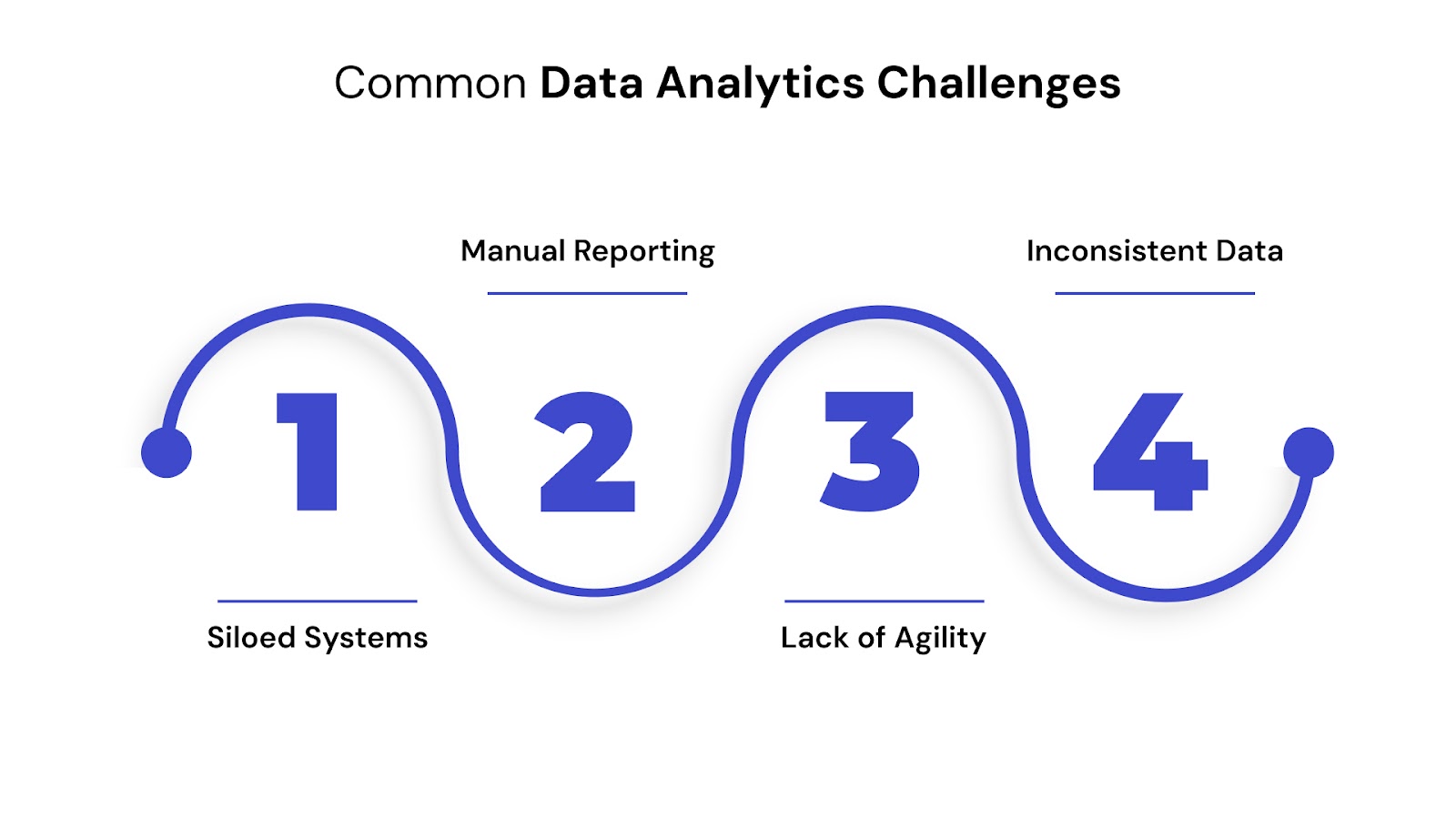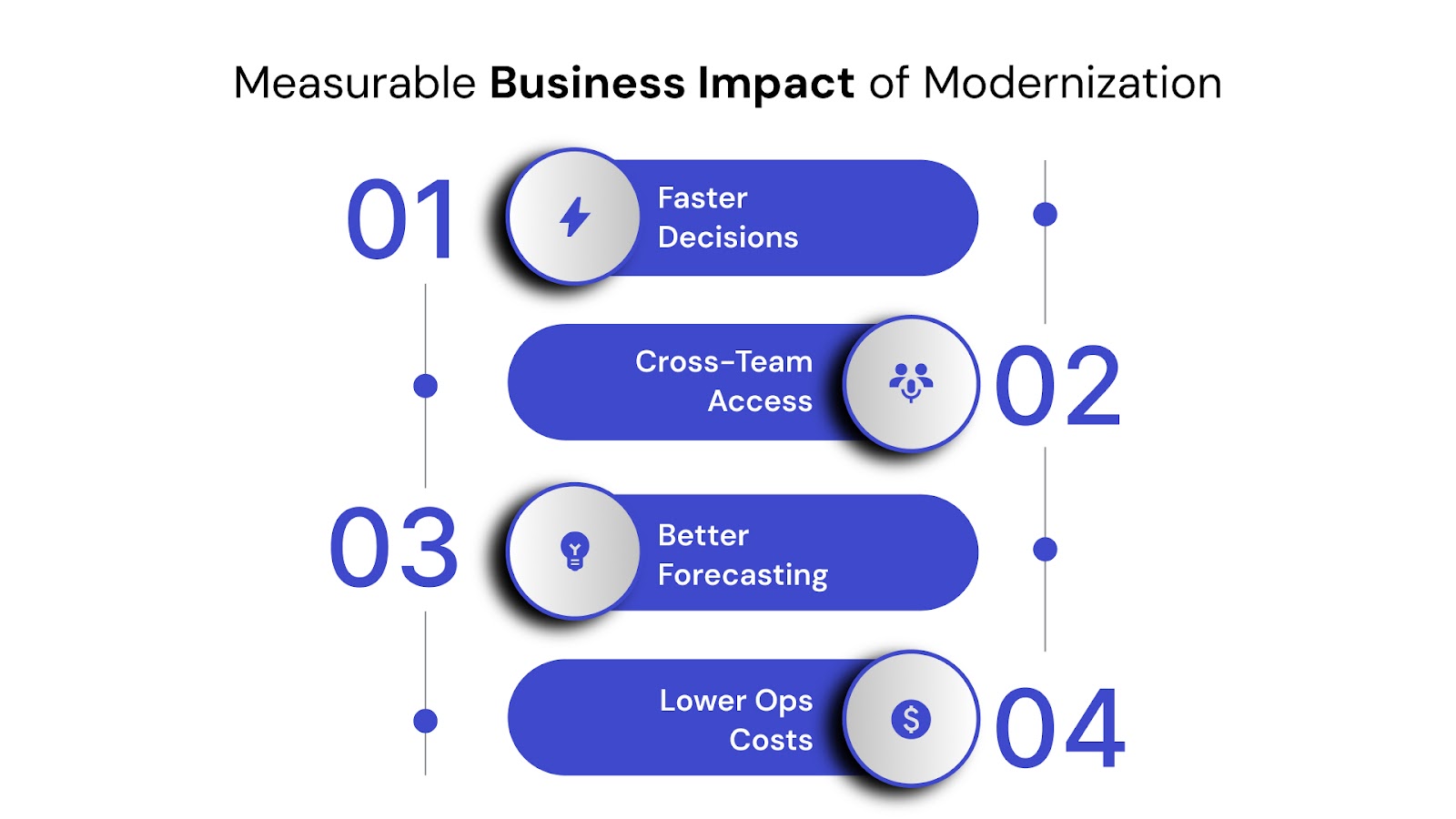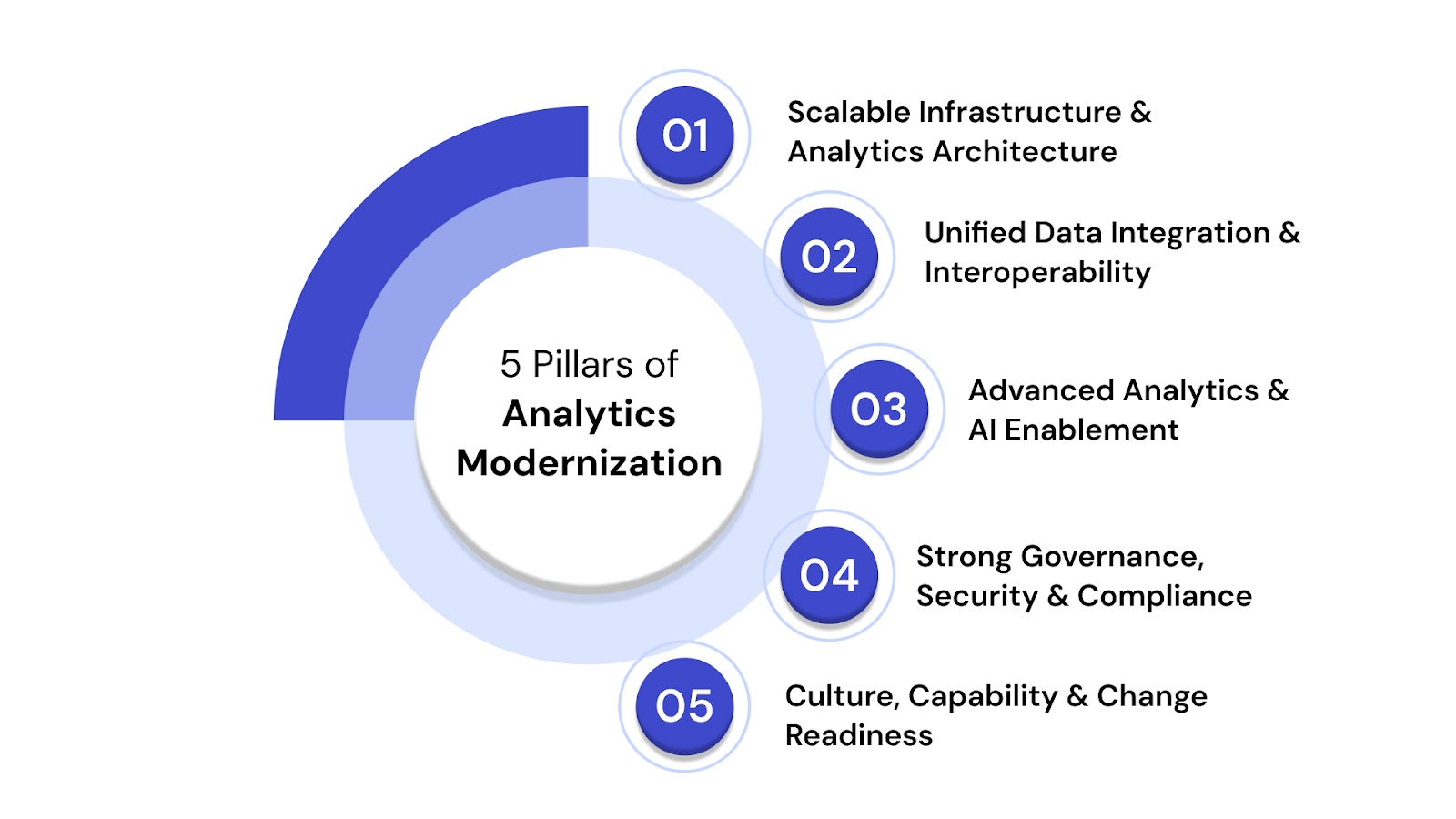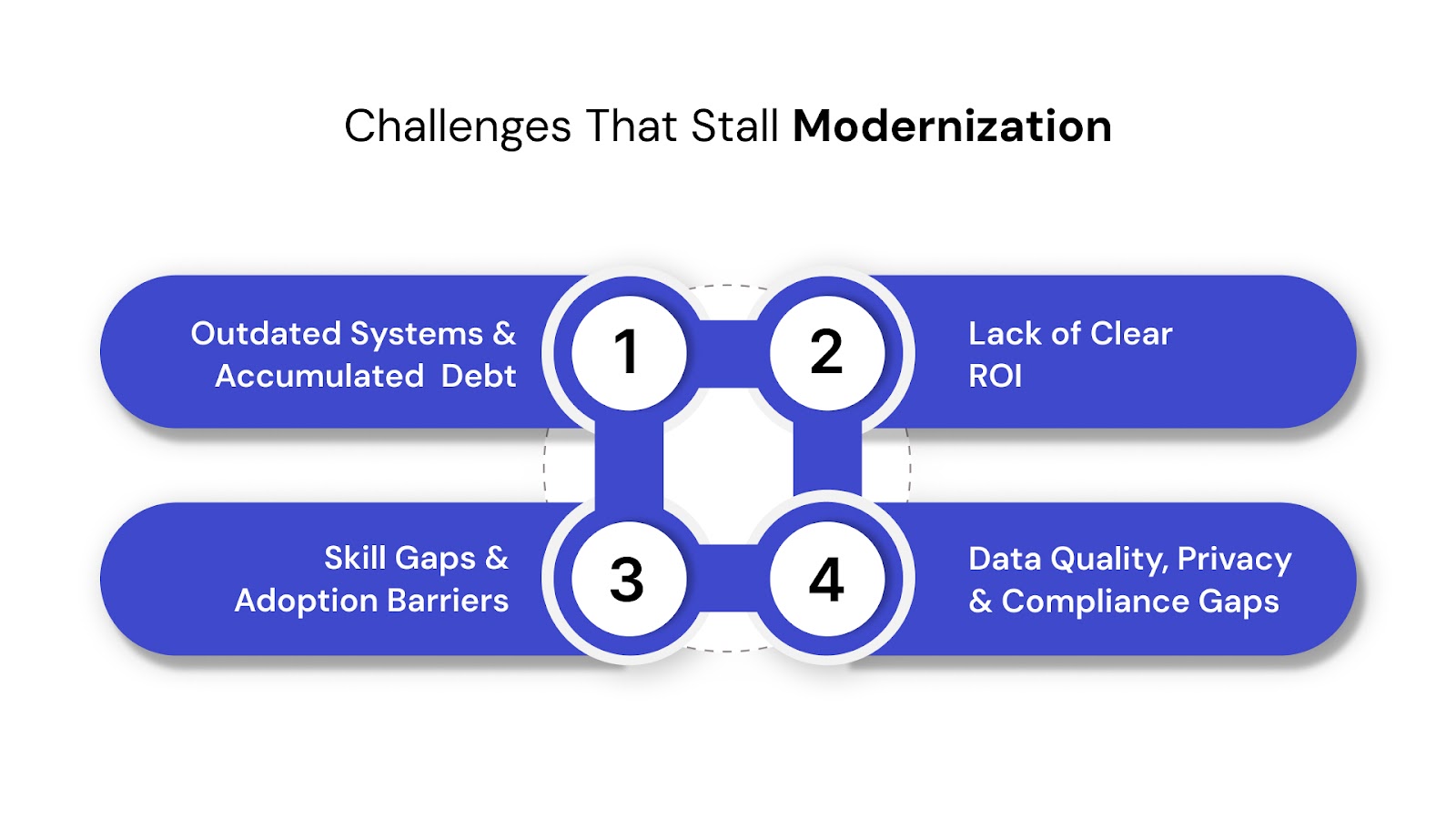.jpg)

In 2025, analytics modernization is about adopting scalable architectures, intelligent tooling, and real-time systems to meet shifting business demands. With 73% of organizations prioritizing analytics for digital transformation, moving to cloud-native systems and integrating AI-driven workflows is already reshaping industries like finance, healthcare, and retail through faster insights and automated reporting.
This blog explores why analytics modernization matters, the five practical steps to implement it, essential tools powering the shift, and what comes next. You’ll gain clear direction and actionable insights to modernize your analytics with confidence and precision.
Analytics modernization is no longer a tech upgrade—it’s a strategic shift. Businesses face mounting pressure to make faster, more accurate decisions with data that’s often delayed, fragmented, or hard to access. Modernization solves these pain points by streamlining data flow, automating insights, and enabling real-time decision-making across teams.

Most organizations still operate with analytics systems that were built for a slower pace of business. These setups often create bottlenecks, errors, and misalignment between departments.
These issues don’t just waste time—they directly affect strategy, budgeting, and customer experience.
Looking to turn your analytics modernization efforts into long-term business value? Learn how to design a strategy that scales with your goals and drives real impact.

Upgrading analytics isn’t just about tech—it drives clear business outcomes. Modernized systems help teams access insights faster, work across departments, and predict business needs more accurately.
These results speak to leadership priorities: speed, accuracy, and savings.
Analytics modernization is already creating impact across sectors by solving real business challenges.

Modernizing analytics requires more than adopting new tools—it demands a structured plan. This section outlines five key steps that help organizations assess readiness, define goals, and implement solutions without disrupting operations. Each step is actionable, aligned with business outcomes, and designed to reduce risks while driving measurable improvements.
Start with a full audit of your existing analytics stack, workflows, and team capabilities. Identify which systems are outdated, where delays occur, and how well your current tools support decision-making.
Every modernization effort needs clear goals linked to business performance. Set outcome-based targets that are specific, measurable, and realistic.
Tool selection should be guided by compatibility, scalability, and ease of use. Don’t just follow trends—choose platforms that fit your team’s needs and data architecture.
Curious how teams are using natural language to unlock insights faster? Explore how conversational analytics simplifies data access and boosts decision speed.
Avoid full-platform switches. A phased rollout lets teams adapt and reveals technical or workflow issues early.
Technology alone won’t deliver results. Your team needs the skills and clarity to use new tools effectively.

Analytics modernization is built on five core foundations. These pillars ensure that improvements are scalable, secure, and supported by both systems and people. Ignoring any of them often leads to poor adoption, inefficiencies, or long-term failure.
Modern analytics needs infrastructure that can grow with data volume and usage demands. This means moving away from rigid systems and adopting flexible setups that support change.
Disconnected data systems make it hard to get consistent insights. Integration allows tools, platforms, and departments to share reliable data in real time.
Modern analytics systems should help teams predict outcomes and act quickly. Static dashboards are no longer enough.
With more data flowing through systems, security and control are critical. Every data point must be traceable, secure, and policy-compliant.
Technology only works if teams are ready to use it. Building the right skills and habits is key to sustainable modernization.
Want to fix slow pipelines or messy data flows? Discover how to streamline ingestion with proven practices and prepare for what’s next in data movement.

Effective analytics modernization depends on selecting the right tools across the data stack. From infrastructure to access, each category plays a role in speed, scalability, and adoption. This section outlines essential categories and trusted platforms that support scalable analytics transformation without going deep into technical features.
Modern architectures like data warehouses, lakehouses, and data mesh enable centralized yet flexible analytics. These solutions support collaboration across teams and allow for real-time access at scale.
Speed and automation are key to keeping analytics current. Modern ETL/ELT tools and orchestration engines automate data movement and transformation while reducing engineering overhead.
These tools bring insights directly to decision-makers. They empower teams to build reports, explore data, and ask questions without relying on IT.
Modern analytics needs visibility and trust in data. These tools help document, monitor, and maintain data quality across platforms.
To scale analytics across the organization, business users need tools they can use independently. These platforms simplify access without sacrificing depth.
Building a modern analytics stack? Explore the latest data engineering tools that power scalable pipelines and support real-time, AI-ready analytics.

Modernizing analytics is rarely smooth. Legacy tools, skills gaps, unclear ROI, and data risks often slow progress or block adoption entirely. This section outlines the most common obstacles and provides actionable strategies to help you move forward with clarity.
1. Outdated Systems and Accumulated Technical Debt
Legacy platforms often create silos, require manual effort, and limit scalability. For example, a reporting system that takes three days to compile data delays decision-making and creates versioning issues across departments.
2. Lack of Clear ROI and Stakeholder Alignment
Non-technical stakeholders often hesitate to approve modernization projects without seeing immediate returns. A data upgrade project may be deprioritized unless it’s linked to reducing churn or improving margins.
3. Team Skill Gaps and Adoption Barriers
Even the best tools fail if users aren’t trained to use them. A team stuck with spreadsheets may ignore self-service BI platforms, reverting to manual workarounds that slow progress.
4. Data Quality Risks, Privacy Issues, and Compliance Gaps
Poor data quality or unsecured access can lead to incorrect reporting or even legal penalties. A missing compliance field or exposed customer record can trigger financial and reputational damage.
Analytics modernization is no longer just about replacing tools—it’s becoming a foundational part of how organizations operate. The next wave focuses on automation, decentralized control, continuous insight delivery, and long-term investment in data culture. This section explores four key shifts shaping the future of modern analytics.
1. Always-On Analytics Through Continuous Intelligence
Continuous intelligence delivers insights in real time, enabling fast, event-driven responses. Unlike scheduled dashboards, it monitors data streams and triggers actions as events occur.
2. From Centralized BI to Decentralized, Domain-Led Models
In traditional BI, a central team controls access, models, and reports. A decentralized model like data mesh gives business units ownership of their data products, speeding up delivery and improving relevance.
3. AI-Driven Decision Making and Autonomous Workflows
AI will increasingly move from supporting decisions to making them. Instead of suggesting actions, modern systems will trigger responses based on predictive models and real-time signals.
These workflows reduce manual oversight and help businesses scale intelligence faster.
4. Modernization as an Ongoing Operating Strategy
Analytics modernization should be treated as a continuous program, not a one-time project. Tech, processes, and user expectations all evolve—and your data strategy must evolve with them.
At QuartileX, our data governance solutions provide comprehensive metadata management to secure data assets when modernizing.
Here’s a rundown on some of our core data governance capabilities:
Modernizing data and analytics demands advanced security measures and real-time quality checks to maintain data consistency during migration from legacy systems to more advanced solutions. Discover QuartileX's data governance services to future-proof your business.
Analytics modernization in 2025 is about more than tools—it’s about building scalable systems, aligned teams, and continuous insights that support faster decisions. To succeed, organizations must audit their current state, define clear goals, adopt the right technologies, and invest in team readiness. Prioritize phased rollouts, measurable KPIs, and long-term planning. The key is to treat modernization as an ongoing capability, not a one-time initiative.
Many organizations struggle to move beyond legacy systems or prove ROI, stalling critical upgrades. QuartileX helps businesses overcome these challenges with structured roadmaps, industry-aligned strategies, and expert-led implementations. Our solutions are tailored to deliver analytics maturity across architecture, data flow, governance, and adoption.
Talk to our data experts today to assess your current analytics stack and build a modernization strategy that actually delivers results.
A: Analytics modernization involves upgrading data systems, tools, and workflows to support real-time insights and scalable decision-making. It’s essential in 2025 as businesses adopt AI, cloud, and event-driven operations.
A: If you're facing delays in reporting, siloed data, or outdated dashboards, it’s time to modernize. These are signs your current setup can't support strategic decisions.
A: Start by auditing your infrastructure, defining business-aligned goals, and identifying gaps in tools or skills. A phased roadmap minimizes risk and improves adoption.
A: Involve cross-functional teams including IT, data engineering, business analysts, and end-users. Success depends on aligning technical execution with business needs.
A: QuartileX offers governance-first modernization strategies, helping you align architecture, tools, and teams. Their experts build tailored roadmaps that focus on scalability, compliance, and ROI.
From cloud to AI — we’ll help build the right roadmap.
Kickstart your journey with intelligent data, AI-driven strategies!